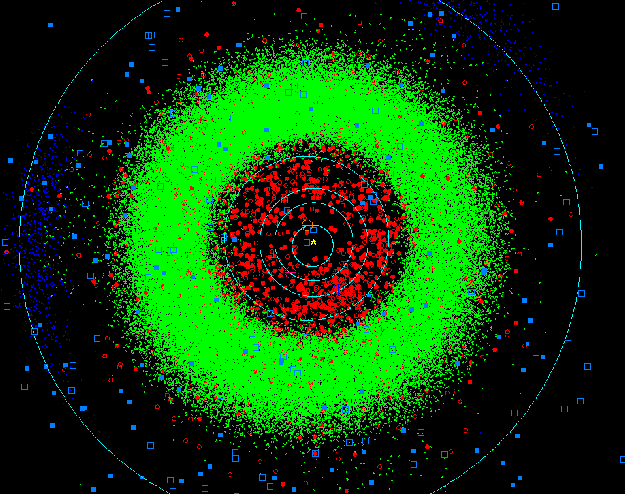APOD.pl: astronomiczne zdjęcie dnia
Codziennie nowy obraz lub zdjęcie naszego fascynującego Wszechświata
wraz
z krótkim objaśnieniem napisanym przez zawodowego astronoma.
Zobacz więcej!

Nasz zatłoczony Układ Słoneczny
Źródło i prawa autorskie:
MPC,
CBAT,
Harvard CfA,
IAU
Opis: Nasz Układ Słoneczny jest tłocznym miejscem. Chociaż najlepszą prasę mają główne planety Układu, istnieje również rój komet, planetoid i skał. Powyższy wykres pokazuje rozmieszczenie znanych obiektów wewnętrznego Układu Słonecznego 20 lipca 2002 r. Jasnoniebieskie linie wskazują orbity planet. Zielone kropki wskazują planetoidy, nazwane oficjalnie planetkami. Czerwone kropki natomiast wskazują planetoidy, które znajdują się w odległości 1,3 odległości Ziemia-Słońce (AU) od Słońca, przez co stwarzają zwiększone (choć niewielkie) ryzyko zderzenia z Ziemią. Komety ukazane są, jako ciemnoniebieskie kwadraty, podczas gry ciemnoniebieskie kropki, to Trojany Jowisza, planetoidy, krążące tuż przed lub tuż za Jowiszem. Zauważ, że większość planetoid wewnętrznego Układu Słonecznego krąży między Marsem a Jowiszem w głównym pasie planetoid. Każdego dnia ów wykres przesuwa się, a obiekty najbliżej Słońca zazwyczaj przesuwają się najbardziej. Aktualne położenie wszystkich tych obiektów można znaleźć tutaj.
Jutro: promienie X z tlenu
<
| Archiwum
| Lista tematyczna
| Szukaj
| Kalendarz
| Słownik
| Edukacja
| O APOD
| Forum
| >
Autorzy i wydawcy:
Robert Nemiroff
(MTU) &
Jerry Bonnell (UMCP)
NASA Official: Phillip Newman
Specific rights apply.
NASA Web
Privacy Policy and Important Notices
A service of:
ASD at
NASA /
GSFC
& Michigan Tech. U.